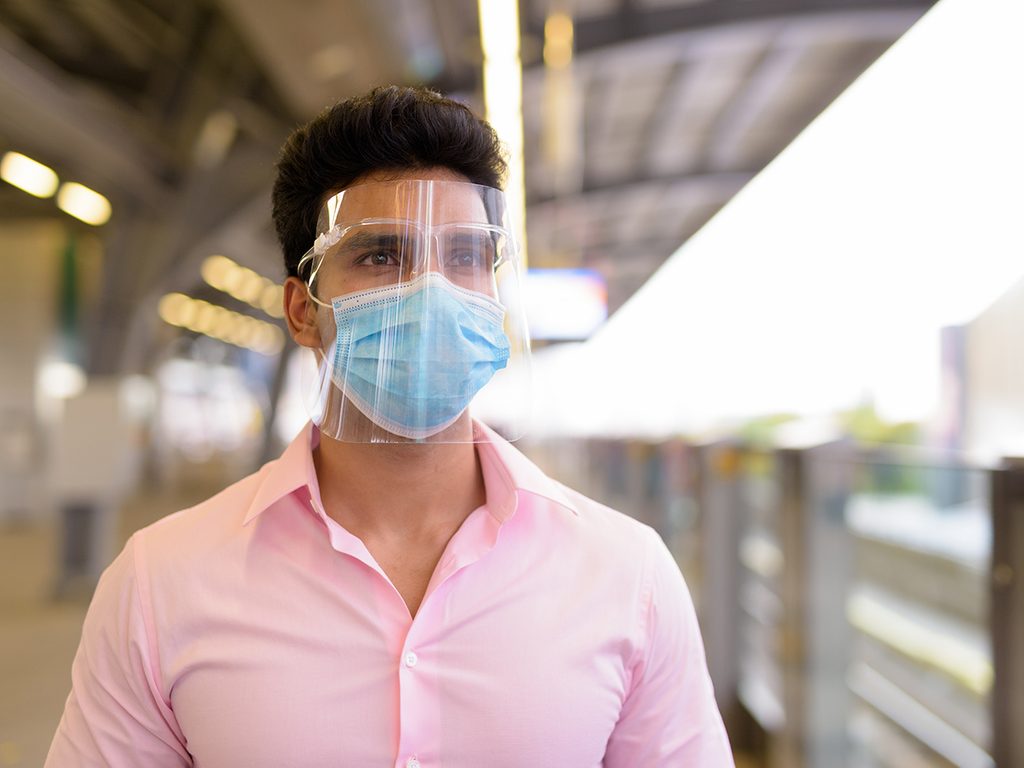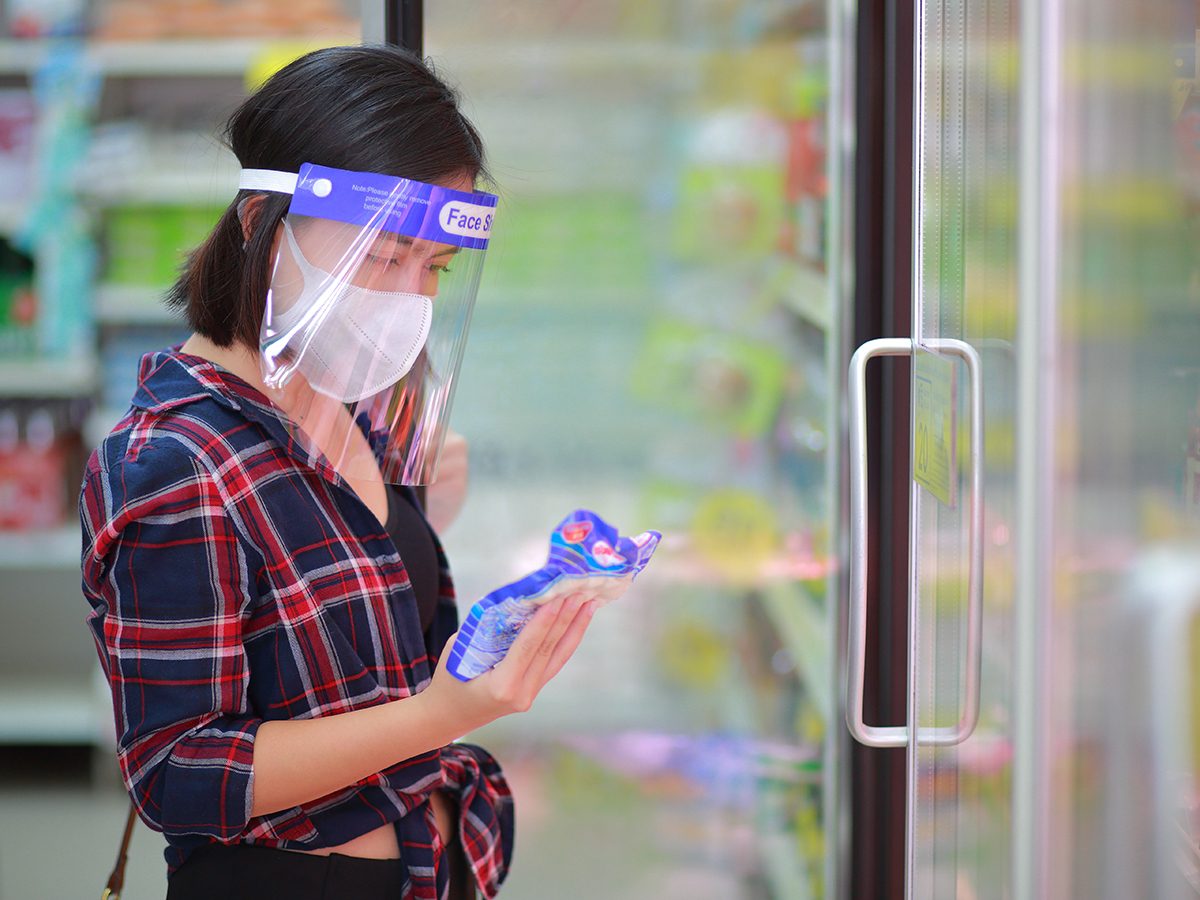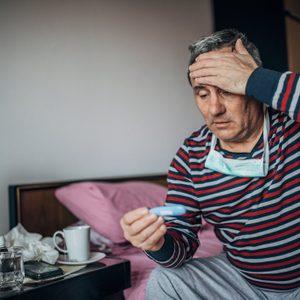Do Face Shields Really Help Stop Coronavirus?

Face shields can provide COVID-19 protection, but only if you wear them with a face mask. Here's why and what else you need to know.
Should you wear a face shield?
With more than 204,000 cases of COVID-19 in Canada and the number growing everyday, it’s important more than ever to avoid catching or spreading coronavirus. It’s also the start of cold and flu season, which means even more potentially dangerous viruses will be circulating.
Public health guidance still advises face masks and social distancing, but what about face shields? These clear plastic full-face coverings seem like a good alternative to wearing a mask: You may feel like you can breathe more easily and people can see your whole face and mouth. (Don’t miss how to read people’s faces when they are wearing a mask.)
Face shields, however, aren’t recommended for protecting against COVID-19 unless you’re also wearing a face mask underneath. So far, the scientific evidence shows droplets can escape the face shield and possibly infect others.
“Data regarding just how effective face shields are in real-world situations is still relatively rare,” says Michael Chang, MD, an assistant professor of infectious diseases at McGovern Medical School at UTHealth in Houston. “That said, we can make some potential inferences based on what limited data is available, and still think about what might be best practices for eye protection in addition to face masks that cover the nose and mouth.” (These 10 facts will convince you to wear a face mask.)
Face shields work differently than face masks
Unless you’re wearing a space helmet or hazmat suit, face shields usually just cover the front of the face.
“Generally speaking, face shields that people are going to tolerate do not seal around the face very well,” Dr. Chang says. “Face masks are primarily to catch infectious droplets and aerosols coming out from an infected person, and so a close-fitting multi-layer cloth or fabric mask covering the nose and mouth would logically be able to block more virus going out than a face shield with large gaps.” (Learn how to make a DIY face mask—no sewing required!)
When considered in terms of keeping the virus confined, it seems clear that a face shield won’t be as effective as a mask, he says. (Here’s 11 mistakes you’re probably making with face masks.)
What the science says
Dr. Chang says that clinical research comparing face shields versus face masks is still lacking. But one simulation study by Florida Atlantic University (FAU), published in September 2020 in the journal Physics of Fluids, used a dummy wearing a face shield to see how aerosol-sized droplets would behave.
“We visualized respiratory exhalations from mechanically emulated coughing from the mouth of a mannequin wearing a shield,” says study author Manhar Dhanak, a professor of ocean and mechanical engineering.
Researchers pumped air mixed with aerosolized droplets of distilled water and glycerin through the mannequin to mimic coughing. Then they used a green laser light sheet to see where the droplets landed.
The findings suggest that although some of the forward motion of aerosol-sized droplets was blocked by the face shields, it didn’t prevent all particles from escaping.
“Putting a shield on a mannequin did not stop the spread of the droplets,” Dhanak says. “They escaped from the bottom and side of the shield and spread around the mannequin.”
Face shields are not able to stop the spread of aerosolized droplets as well as good quality masks, he says. (Here’s what the anti-mask movement needs to know about COVID-19.)
Size of droplets and COVID-19 transmission
One uncertainty is whether only larger droplets, which fall fairly quickly to the ground, transmit the virus; or if “aerosolized” droplets, which are smaller and hang in the air longer (and escape face shields more easily), can also transmit it. (These are the five places you’re most likely to catch coronavirus.)
“These aerosols are smaller than the larger droplets that we typically consider for most respiratory viruses,” Dr. Chang says. “These aerosols can linger in the air longer and travel further than the large droplets, which typically fall out of the air within six feet.”
This is where scientists have determined the six-feet rule of social distancing. (Learn how to handle social distancing rule breakers, according to etiquette experts.)
So why did the research focus on aerosol-sized droplets? In general, “studies suggest that respiratory exhalations contain droplets of a range of sizes, including aerosol size,” Dhanak says. “They all have the potential of carrying viruses. The aerosol-sized droplets tend to linger longer and travel further, and therefore pose a risk of airborne transmission.”
The Centers for Disease Control and Prevention (CDC) recently released guidance that backs this up.
“Based on the CDC’s latest guidance stating that the virus can sometimes spread through airborne particles, those particles can easily work their way around the large gaps that typical face shields have, and both travel out and away from an infected person as well as get around a face shield and infect someone,” Dr. Chang says. (Here’s why some people are more likely to spread COVID-19 than others.)
He also points to an older 2014 simulation study which shows face shields were effective at blocking large particles from transmitting the influenza virus, but not smaller particles.

Wearing face shields with masks
Emerging research suggests that if you wear a face shield in addition to a mask, you might be better protected than if you wear only a mask. In a JAMA study published in August 2020, researchers found that cases among COVID-19 health care workers dropped when they began wearing face shields in addition to masks and other PPE (personal protective equipment).
“While not examining face shields alone without masks—ie, face shields as a replacement for masks—there was a clear reduction in positive SARS-CoV-2 cases when face shields were added to masks, gloves and hand hygiene,” Dr. Chang says. “The reason for the reduction is not clear. The takeaway, however, is that a face shield in addition to a mask seems to be more effective.”
In general, “systematic reviews for health care workers do demonstrate that hand hygiene coupled with the complete set of PPE, with masks, gowns, and eye protection are the most effective at preventing infections spreading from patient to provider,” Dr. Chang says. “In the hospitals, when we see patients that are known to be COVID-19 positive or waiting for a COVID-19 test result, we are wearing eye protection.” (These are the nine things doctors need you to know about face masks.)
COVID-19 and your eyes
This is another aspect of COVID-19 transmission that’s likely but doesn’t have a lot of clear-cut scientific research yet. “With SARS-CoV-2, there is not a lot of data about exactly what percentage of infection happens from the eyes versus nose and mouth,” Dr. Chang says.
Plus, “it’s not clear exactly how many COVID-19 cases are due to spread via the eyes only, in patients that were actually wearing a face mask.”
Still, “contaminated fingers that then rub or touch the eyes can be a source of infection for other respiratory viruses, and likely for SARS-CoV-2 as well,” he says. Some viruses, such as adenoviruses (pink eye) are really good at getting in through the eyes, he says; but most respiratory viruses also get in through “mucosal surfaces” that include the eyes in addition to the nose, mouth and throat. (Is it allergies or pink eye? Here’s how to tell the difference.)
Interestingly, a September 2020 study published in JAMA Ophthalmology shows that daily eyeglass wearers made up a smaller percentage of COVID-19 cases than would be expected given the estimated number of those who wear glasses. (This is how to keep your glasses from fogging up while wearing a mask.)
But “it’s not really a study that you can draw definite conclusions from though, since it’s just an observation of the percentage of COVID-19 infected patients that were reported to be daily eyeglass wearers against historical estimates of eyeglass wearers,” Dr. Chang says. And the study only showed a link, not cause and effect.
Eye protection and face masks
Right now, eye protection isn’t universally recommended by the CDC (only for health care workers), but Anthony Fauci, MD, physician, immunologist, and director of the National Institute of Allergy and Infectious Diseases, has recommended using it if you can.
“You have mucosa in the nose, mucosa in the mouth, but you also have mucosa in the eye,” Dr. Fauci said in an Instagram Live conversation on ABC News. “Theoretically, you should protect all the mucosal surfaces. So if you have goggles or an eye shield you should use it.”
Dr. Chang agrees: “Yes, I do think that eye protection would add protective benefit for an individual with respect to COVID-19.” Particularly, “I think for high-risk individuals it may make sense to wear eye protection in addition to a face mask, especially if they are going to be in a high-risk situation—indoors, without good air circulation, for a period longer than 15 minutes.” (Here are nine tips for using a public washroom during COVID-19.)
Ideally, if you’re at high risk for coronavirus, should try to avoid a high risk situation anyway, he says, but if you can’t, he recommends adding eye protection.
Goggles versus face shields
“This is a good question, still without a lot of data comparing goggles to face shields head to head,” Dr. Chang says. “Historically, for other respiratory viruses such as respiratory syncytial virus (RSV), the addition of goggles to face masks and gowns reduced transmission in health care workers.”
Although whether regular people should wear goggles instead of face shields in addition to masks is unproven, it might make sense. (These are the 10 ways doctors protect themselves from COVID-19.)
“Logically, goggles provide a better seal and are probably better at preventing a person from accidentally touching their eyes,” Dr. Chang says. However, goggles aren’t always practical or tolerable for every situation, he says.
The takeaway
Whether you’re including eyewear or not, you need to use your protection correctly; and you shouldn’t slack off on the other measures for avoiding COVID-19.
“The effectiveness of masks and shields depends a lot on proper use,” Dr. Chang says. And he points out that “hand hygiene is still pretty critical to all this working.” (Here are the seven body parts you’re washing all wrong.)
Just as you shouldn’t fiddle with your mask or wear it wrong (below the nose), you shouldn’t reach up under a face shield to touch your face.
The bottom line on face shields: “At this time, I wouldn’t suggest a face shield as an alternative to a face mask except in specific circumstances where a mask wasn’t available or absolutely intolerable,” Dr. Chang says. “Ultimately, eye protection, whether that is in the form of a face shield or goggles, likely has benefit in addition to physical distancing, masks, hygiene, and, importantly, staying home when symptomatic.”
Next, these are the 13 shortages we’re likely to see this winter because of COVID-19.






